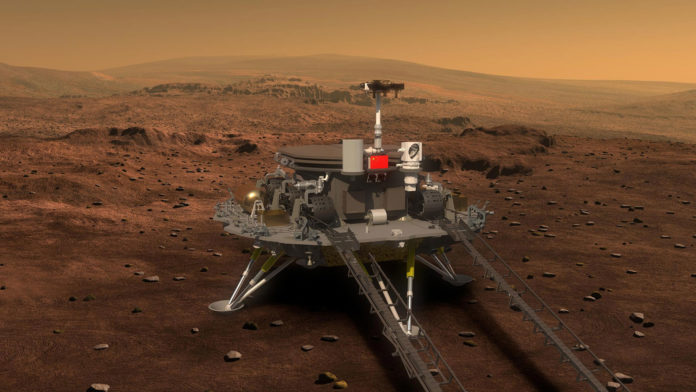Tianwen-1 mission, which the Chinese National Space Administration (CNSA) launched in July last year, is about to step on the surface of Mars. China’s Mars rover, named Zhurong, has touched down on the surface of the red planet on May 14 around 23:11 UTC.
The rover was orbiting Mars aboard the Tianwen-1 spacecraft since February. During this time, it has gathered information about the landing zone. The Chinese team has chosen Utopia Planitia for landing, a huge basin formed by an ancient impact in the northern hemisphere of the planet. The area is a relatively safe place for an attempt to touch Martian soil, as well as being of great scientific interest.
Zhurong will carry out a delicate maneuver to reach Mars, a difficult task, to say the least. So much so that the landing on the red planet has been dubbed by NASA as the “seven minutes of terror.” This is where the lander, also attached to the probe, will come into play.
The rover and lander entered the thin Martian atmosphere protected by a heat shield. The duo then ejected the shield and deployed a parachute to slow its descent.
Zhurong, named after an ancient Chinese God of fire, is 1.85 meters tall and weighs around 240 kilograms. The vehicle is smaller than the heavy one-ton Perseverance. It is powered by the Sun’s energy thanks to its four solar panels, which are expected to keep it moving for 90 Martian days.
The rover has been equipped with six scientific instruments to study Mars’s geological structure, the composition of its surface and underlying layers of rock and ice, its magnetic field, and its climate.
The successful landing of Zhurong allowed the rover to join other missions currently active on Mars. NASA’s Perseverance rovers, which arrived on February 18, and Curiosity, on the planet since 2012, will be the ground companions of the Chinese rover.
After safely landing of Zhurong on Mars, China became the third country to achieve this feat. The first was the Soviet Union in December 1971 with Mars 3, which lost contact with Earth after less than 2 minutes on the surface and did not transmit images. The second was the USA with Viking 1 on July 20, 1976.
